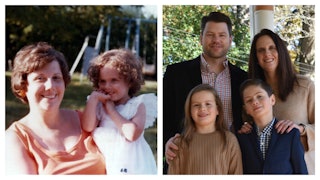My Mom Died Of A Brain Aneurysm, And I Want People To Know The Symptoms

The day started as any normal day did for me as a 7th grader. It was January 12, 1988. As I rushed around getting ready for school, my mom helped me study for my vocabulary test as we bumped into each other as we tried to share the bathroom sink – she was impressed that I knew all of the words on our first run-through, so we eliminated additional studying from that morning’s task list.
She liked my outfit that day (this didn’t happen every day) and told me so – I was wearing light jeans, white keds, and a royal blue Henley. She gave me the normal outpouring of hugs and affection before I took off for the bus stop.There was never a time when this ritual was skipped due to a busy morning. There was always time for hugs.
My day at school was as normal as any day for a middle schooler, meaning it was predictably abnormal. What I didn’t know was that sometime around lunch time, my mom was rushed to the hospital. She suffered a ruptured brain aneurysm, and slipped into a coma. She had surgery, but there wasn’t much they could do. I saw her that night after surgery and it was obvious that our life, my life, was permanently changed in a devastating way.
She turned 42 two days later, and about a week and a half after that, she died. 42 years old is way too young. At 12, I was too young to lose my mom too.
I had always operated under the assumption that brain aneurysms are just unavoidable, bad luck, and come with no warning signs – some people just get struck by lightning. Most people believe this. I did for the past 30 years.
Then 18 months ago, I met a guy named Todd Crawford– his wife Lisa Colagrossi, a former ABC news anchor in NY, also suffered a ruptured brain aneurysm almost 3 years ago and passed away quickly. He realized immediately that there are often warning signs leading up to ruptures and they’re widely ignored –not only by victims and their families, but the medical community. As such, he started The Lisa Colagrossi Foundation to help raise awareness of early warning signs and symptoms to prevent anyone from going through what he and his kids went/are going through. I joined the Board of Directors to help make this mission a reality.
One can have an aneurysm (weakening in the blood vessel), and if identified, there are things that can be done to prevent it from rupturing. Once it ruptures, the results are typically catastrophic. The Lisa Colagrossi Foundation has received multiple letters detailing personal stories of how he or she credited the foundation with helping them and/or a family member recognize early symptoms, resulting in going to the ER immediately and potentially saving their life.
As I reflected, I realized how many (now obvious) symptoms my mom suffered. She had the WHOL (worst headache of her life) for over 2 weeks before the aneurysm ruptured, not the typical nagging sinus headache or migraine, but something different. She mentioned the pain often. She had severe neck pain. She had moments of eye twitching and blurry vision/sensitivity to light (based on a recollection I have about driving with her just days before).
She was vomiting on New Year’s eve from the severity of the headache, and hadn’t had a drink. She had gone to a doctor and he gave her penicillin for a glands cold. There was one going around in January 1988 so it seemed like a reasonable diagnosis.
WHOL, neck pain, nausea, eye pain/twitching are a few of the frequent warning signs of aneurysm and impending rupture, which can be detected through an MRA (essentially an MRI of the blood vessels) and treated. Maybe not in 1988, but certainly today. I was dealt a tough set of circumstances, but I implemented #OptionB with a strong support system around me. It’s made me better, more resilient, more focused on the important stuff, and pretty good at not sweating the small stuff.
My mom was incredible and taught me so much in the 12 years we shared on this planet together. She taught me a lot in her passing too, but this doesn’t have to be anyone else’s reality, so look out for more from The Lisa Colagrossi Foundation, be aware of warning signs, and spread the word. Someone’s life might depend on it.
This article was originally published on